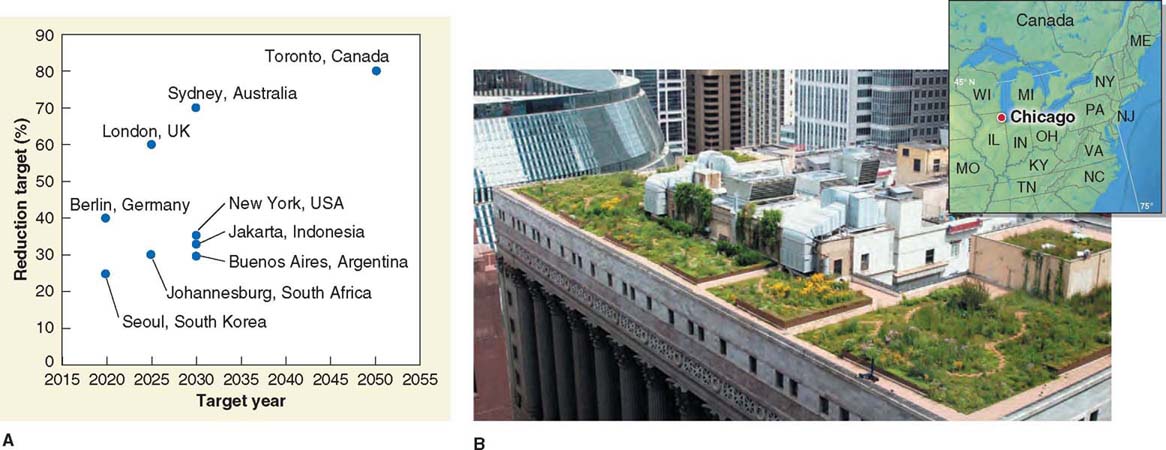6.5 Stabilizing Climate

Assess different approaches to tackling climate change.
On May 9, 2013, the atmosphere’s CO2 concentration reached 400 ppm at Mauna Loa Observatory in Hawai‘i. As the summer progressed, it was drawn back down naturally to the high 390s. At the current rate of increase, atmospheric CO2 concentrations will reach 400 ppm in 2015. It will not drop below that for at least 1,000 years, and probably much longer.
The last time atmospheric CO2 was at 400 ppm was about 3 million years ago, before the Quaternary ice age began (see Section 6.2). At that time, temperatures were 2°C to 3°C (3.6°F to 5.4°F) higher than today. Global sea level was about 25 m (82 ft) higher than today as a result of less glacier ice.
If anthropogenic CO2 emissions continue to grow at current rates, CO2 concentrations will reach 900 ppm by the end of this century (see Figure 6.23A), a concentration that last occurred about 35 million years ago. If CO2 reaches this concentration, we will face a world that is very different from the world we live in today. How can we avoid this scenario?
Twenty-Five Billion Metric Tons
One goal set by climate scientists is to reduce CO2 emissions so that atmospheric CO2 concentrations do not exceed 500 ppm. Doing so could keep future warming within 2°C (3.6°F). On a global scale, yearly CO2 emissions would have to be reduced about 80% from current levels, by about 25 billion metric tons, within the next two decades to keep atmospheric CO2 under 500 ppm.
Reducing the flow of CO2 to the atmosphere by 80% within two decades is a daunting but technologically achievable goal. Accomplishing it will involve a significant restructuring of the way people produce energy and the way people use fossil fuels. Table 6.2 suggests six specific steps we can take to accomplish this goal. If these six actions were fully implemented, CO2 emissions would stabilize by 2050 at about 500 ppm. This table is a small sampling of the many actions that can be taken to reduce global carbon emissions.
|
|
ACTION |
HOW TO DO IT |
|---|---|---|
|
1 |
Cars: Double the fuel efficiency of all cars worldwide and halve the number of miles traveled by cars each year. |
Improve technology in vehicles. Phase out inefficient vehicles. Improve city design and mass transit. |
|
2 |
Buildings: Reduce energy use in all buildings 25%. |
Improve insulation and building design. Improve efficiency of heating and cooling, lighting, and appliances. |
|
3 |
Coal efficiency: Improve coal power plant efficiency from the current 40% to 60%. |
Improve technology for burning coal and converting it to electricity. |
|
4 |
Solar energy: Increase photovoltaic solar power capacity. |
Increase today’s photovoltaic capacity by 700 times. This would require 2 million hectares of land (see Section 2.6). |
|
5 |
Wind energy: Increase wind power capacity. |
Increase today’s wind capacity by about 40 times. This would require 30 million hectares (74 million acres) of land (see Section 4.5). |
|
6 |
Deforestation: Reverse deforestation in the tropics. |
Provide economic alternatives to cutting forests for developing countries. Reduce demand for forest products in developed countries by supporting recycling and more efficient manufacturing. |
Addressing the Problem
There is a growing movement to tackle the problem of climate change on a variety of fronts, from the level of the national government to the individual. Environmentally friendly green economies are quickly growing in many countries. A green economy is a sustainable economic system that has a small environmental impact and is based on renewable energy sources.
green economy
A sustainable economic system that has a small environmental impact and is based on renewable energy sources.
Coping with increased droughts, floods, disease, sea-
International Response
There has been much talk among nations about limiting greenhouse gas emissions. The United Nations Copenhagen Accord in 2009 and the climate change conference in Durban, South Africa, in 2011 were two recent meetings at which the problem was addressed. This work continues with the 2015 climate conference in Paris, where participating nations will agree to legal obligations to cut their carbon emissions. Some 55 nations, which account for 87% of global CO2 emissions, registered an informal commitment to reduce their greenhouse gas emissions. Canada and the United States, for example, have committed to lowering their CO2 emissions by 17% from their 2005 emission levels by the year 2020.
National Response
Carbon taxes are seen by many as the most important legislation at the national level to reduce carbon emissions quickly and efficiently. Carbon emissions beyond a predetermined level could be taxed. This would provide an incentive to produce less carbon.
In a similar scheme, carbon cap-
Carbon taxes are politically unpopular. Voluntary reductions and cap-
Local Response
Half the people in the world live in urban areas, and this percentage is growing. Cities contribute up to 40% of global CO2 emissions. Over 2,800 cities worldwide have formally committed to reducing their CO2 emissions. The C40 Cities Climate Leadership Group is a coalition of major cities committed to reducing their greenhouse gas emissions under specific deadlines (Figure 6.25).

Many states have also initiated emissions reduction goals that are voluntary. California, New York, Michigan, Connecticut, and Florida, for example, have set an ambitious goal of reducing greenhouse gas emissions by 80% (relative to 1990 levels) by the year 2050.
Individual Response
The challenge of coping with climate change can seem overwhelming to an individual. Almost all of our daily activities rely on energy from fossil fuels and emit CO2 into the atmosphere. The average car emits about 5.5 metric tons of CO2 each year. Heating, cooling, and electricity use in the average house in the United States produce about 11 metric tons of CO2 each year.
One approach to the problem is to understand your personal carbon footprint. A carbon footprint is the amount of greenhouse gases (particularly CO2) that any activity generates. There is much literature available on living a low-
carbon footprint
The amount of greenhouse gases (particularly carbon dioxide) any activity generates.
|
ACTIVITY |
HOW TO REDUCE THE CARBON FOOTPRINT |
|---|---|
|
Reduce, reuse, recycle |
Generating less waste and recycling reduce the amount of greenhouse gases emitted by resource extraction, manufacturing, transport, and disposal of materials. |
|
Driving |
Living closer to work, biking, walking, using public transportation, carpooling, and combining errands for fewer trips reduce the amount of fuel burned. |
|
Home energy use |
Insulating the attic and outside walls, LED lighting, and efficient appliances reduce energy use. |
|
Water use |
Purifying and distributing water require energy. Using less water consumes less energy. |
|
Renewable energy use |
Using solar and wind energy decreases reliance on fossil fuels. Many local power companies allow users to select whether their power comes from conventional or renewable sources. |
|
Diet |
Raising livestock for meat is more carbon- |
|
Flying |
Flying is a carbon- |
|
Political engagement |
Climate- |
|
Carbon offsets |
Carbon offsets are investments in renewable, carbon- |
Since the year 1976, every decade has been warmer than the previous one (see Figure 6.17). Atmospheric CO2 concentrations and temperatures continue to rise. At the same time, green economies and active reduction of carbon emissions are developing a growing momentum. At present, no one yet knows how this planetary-